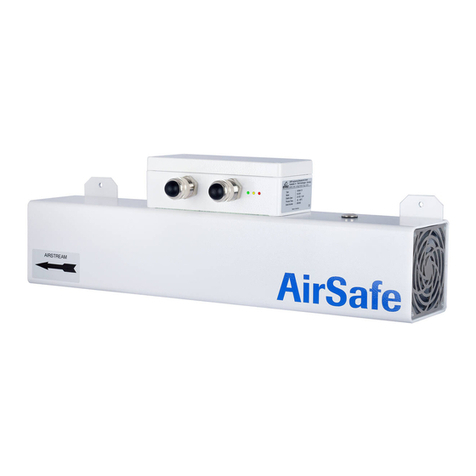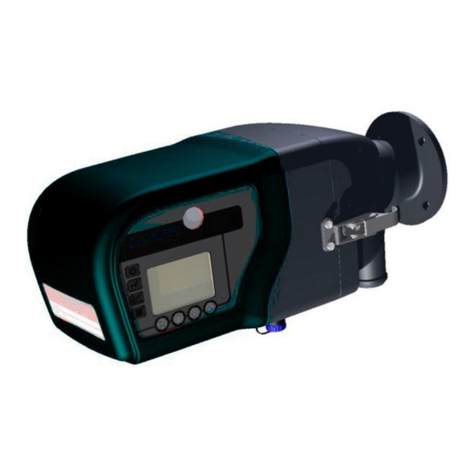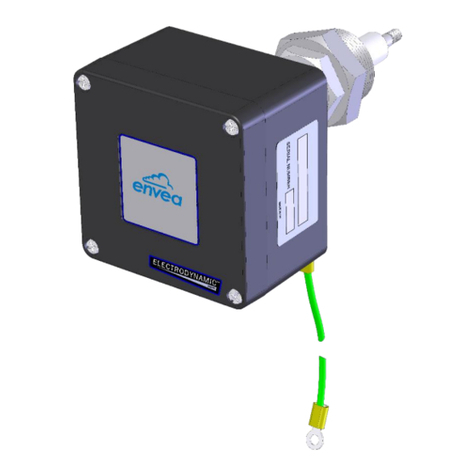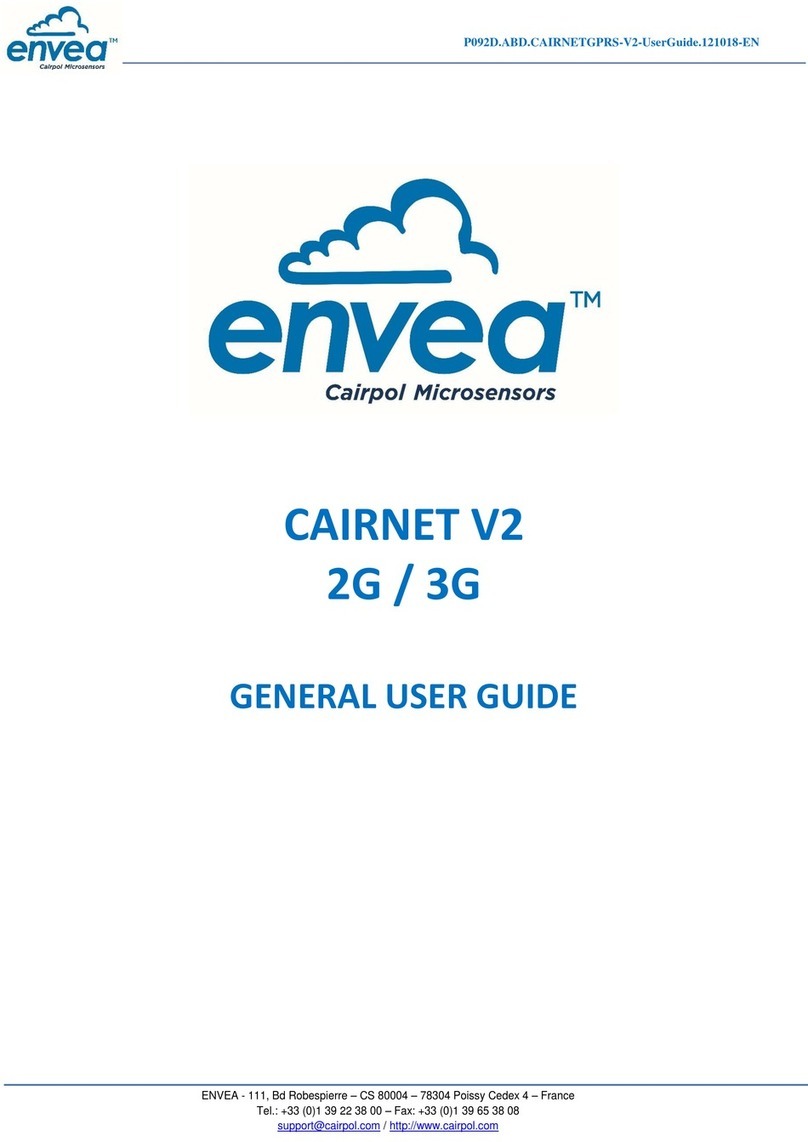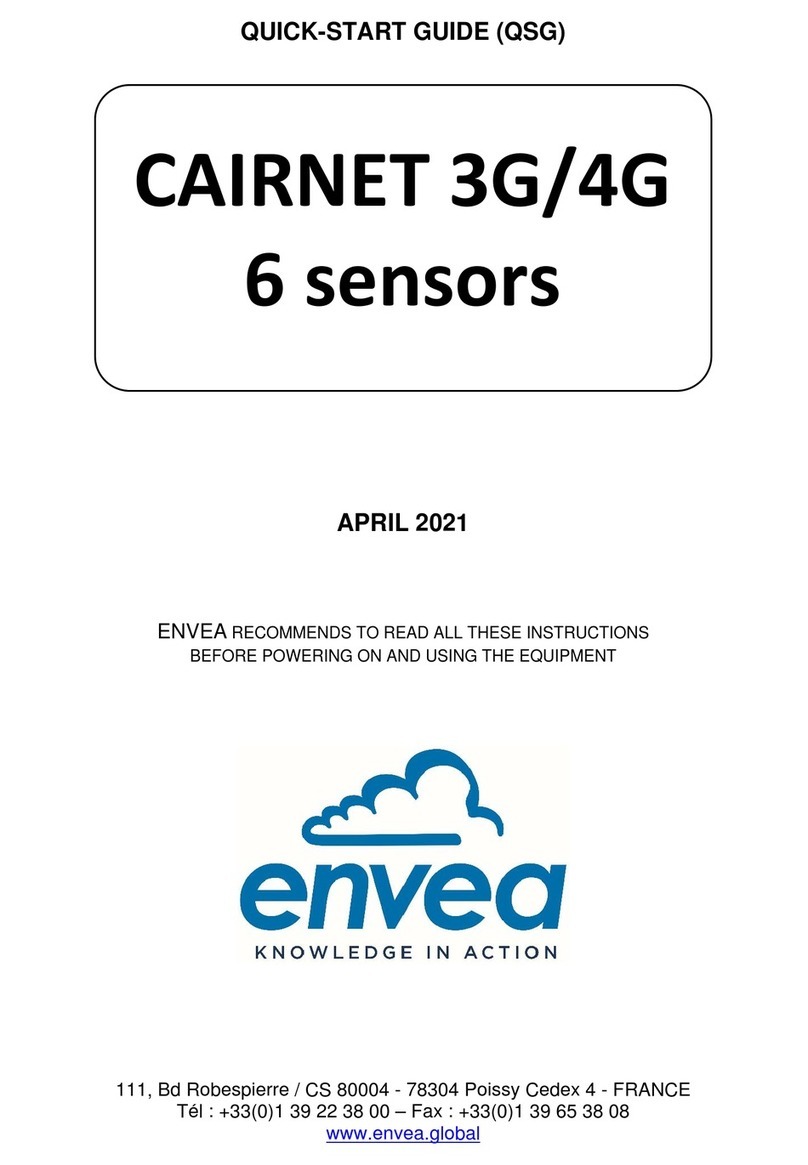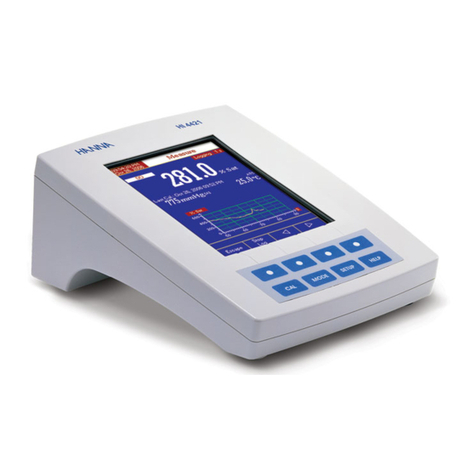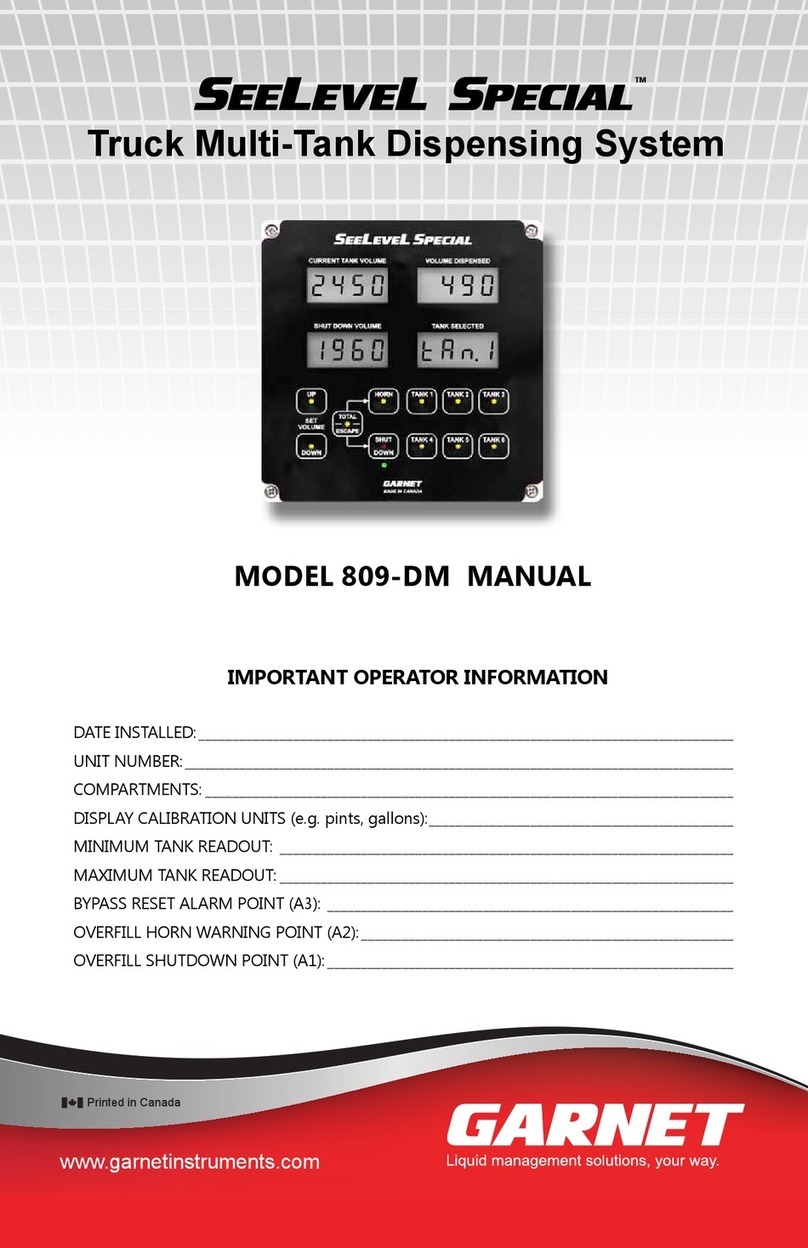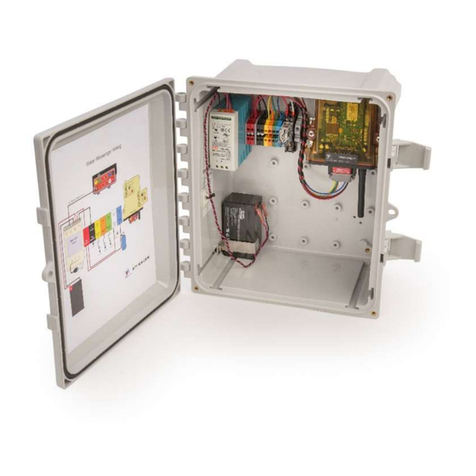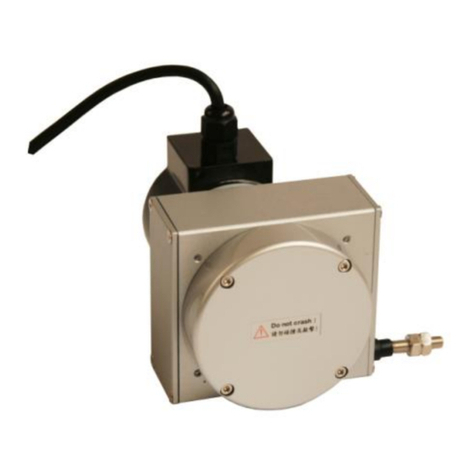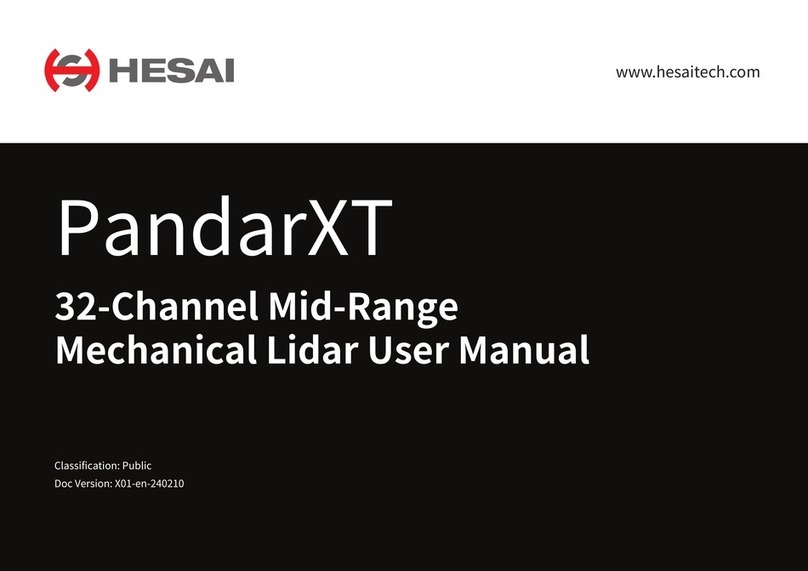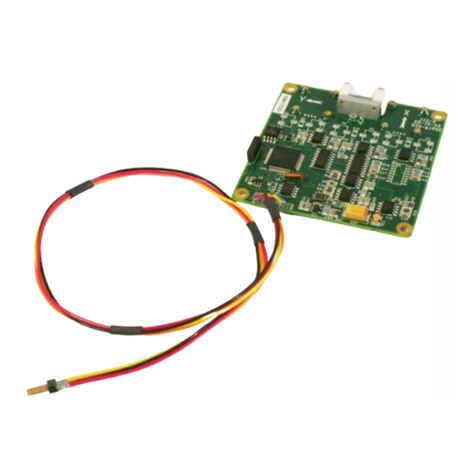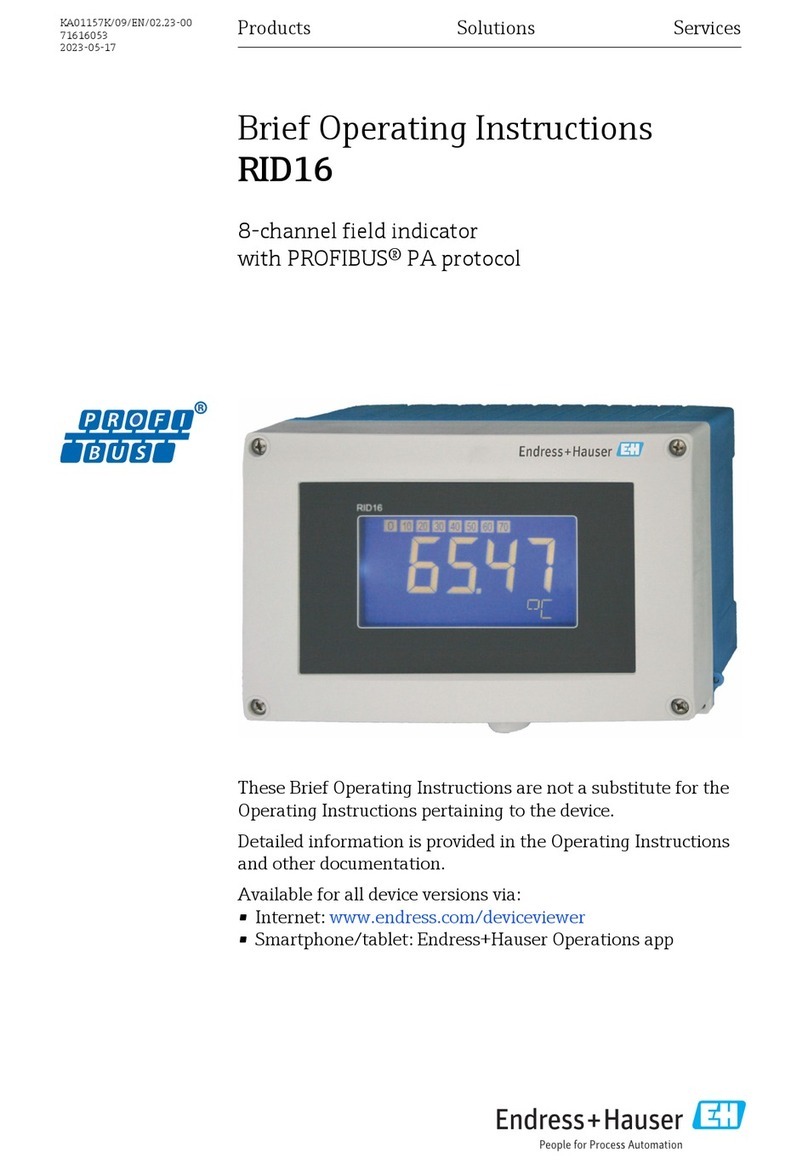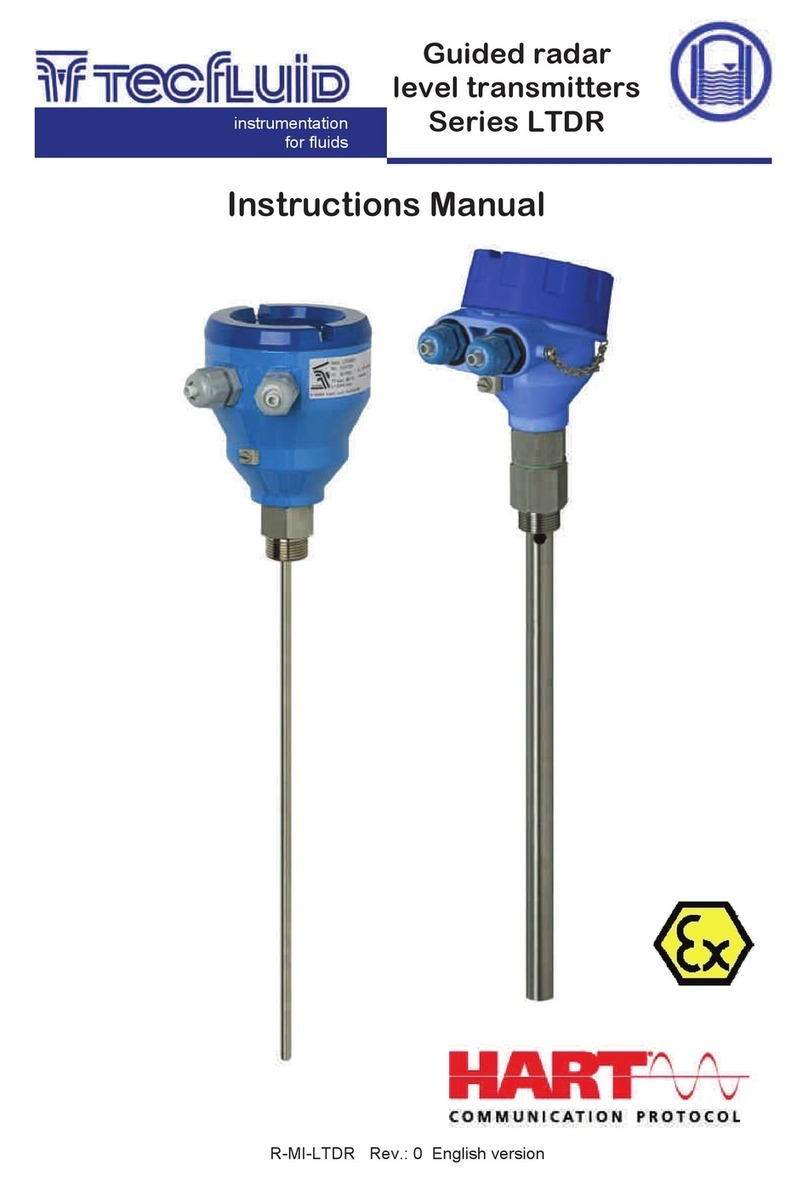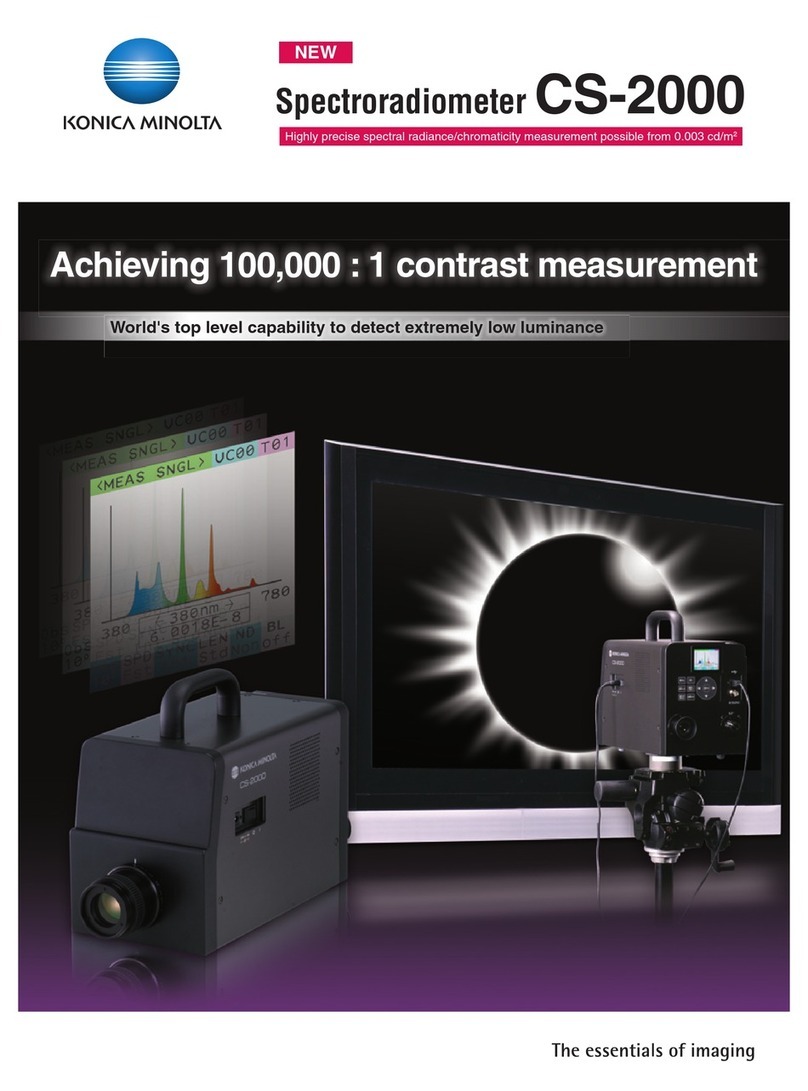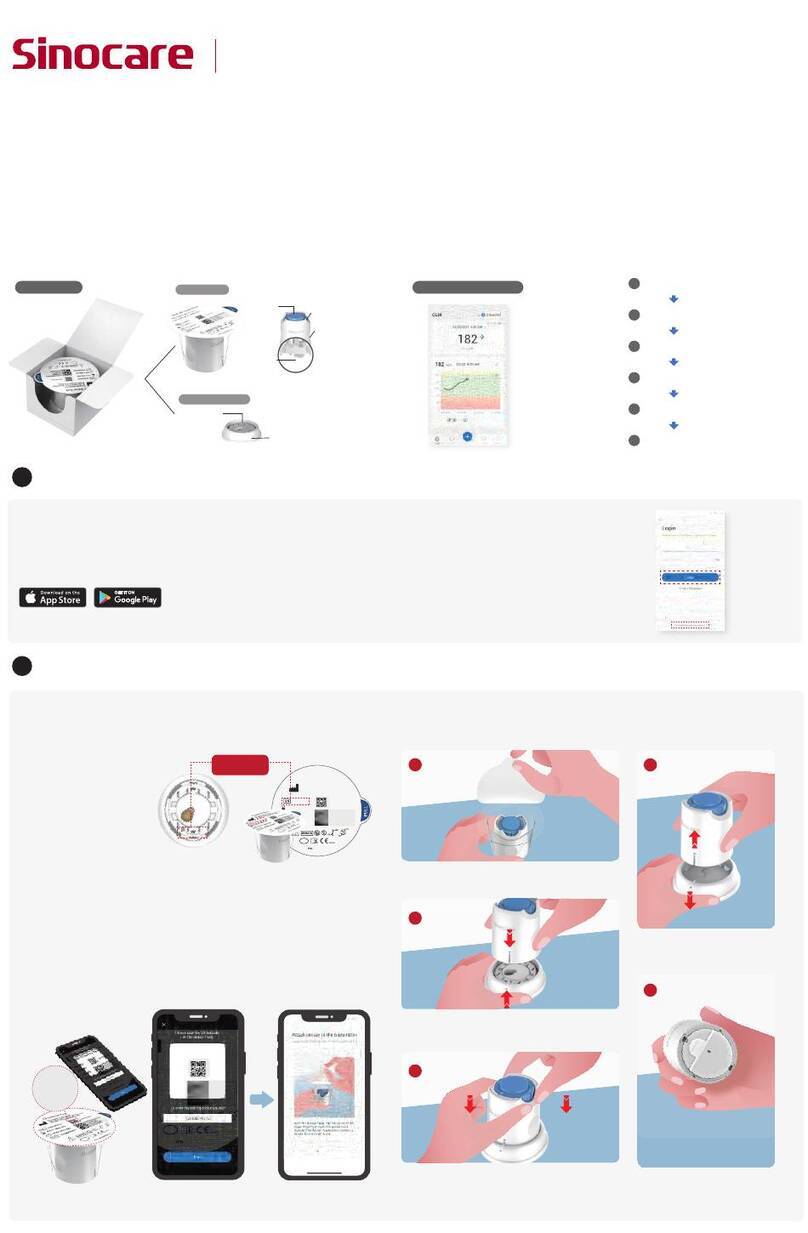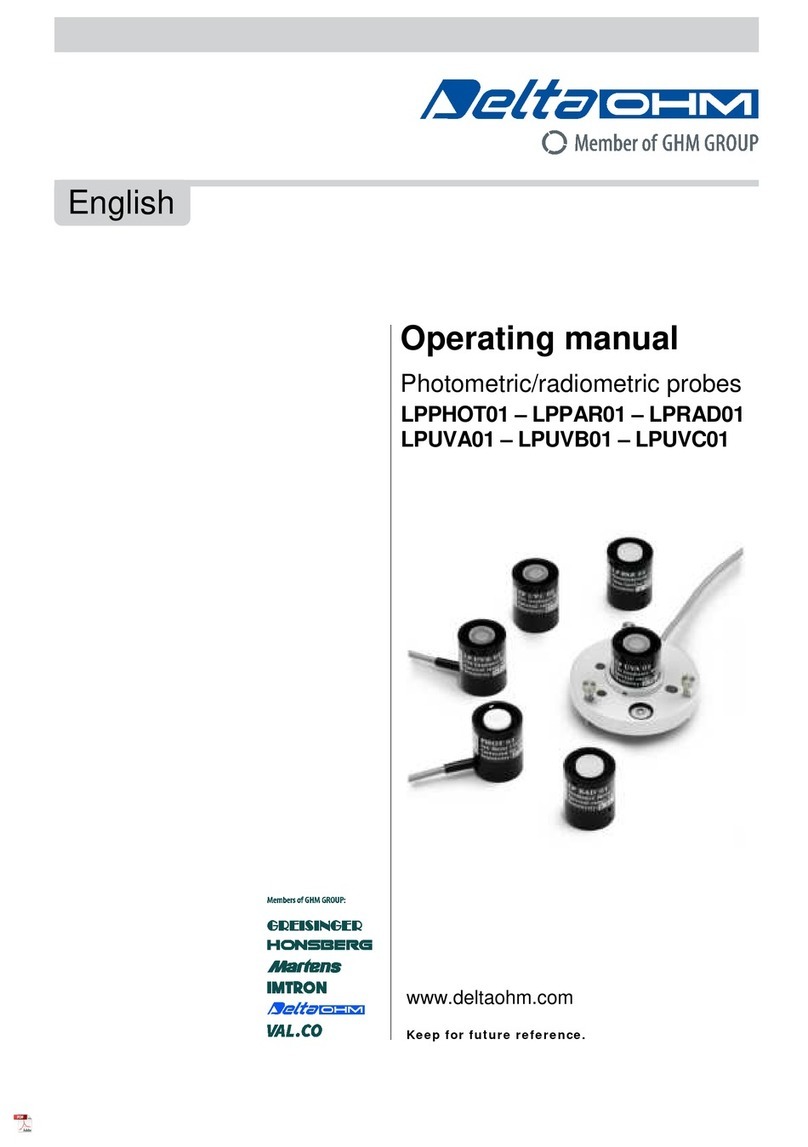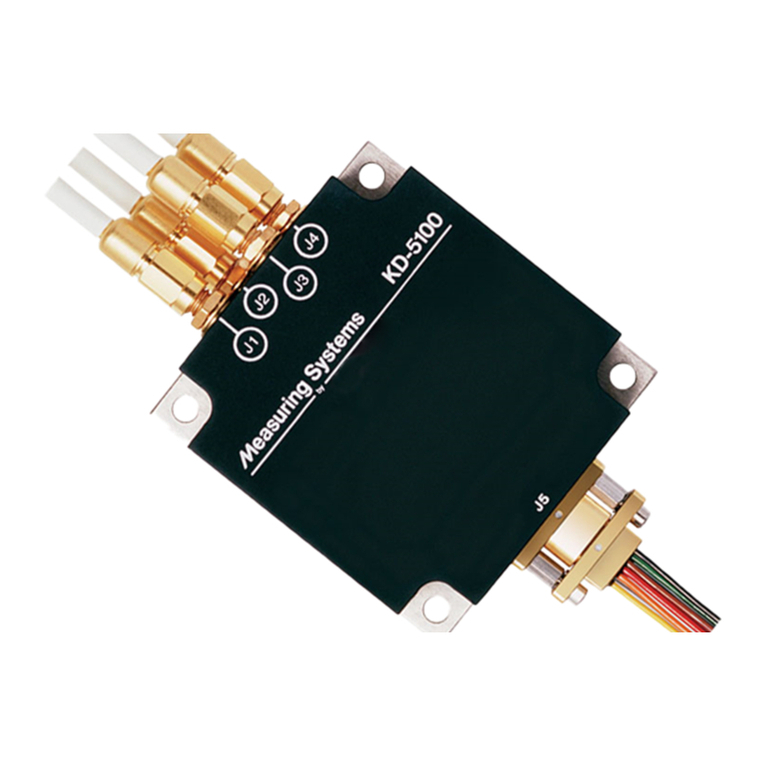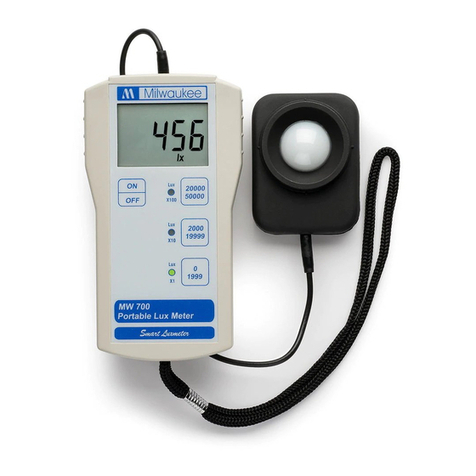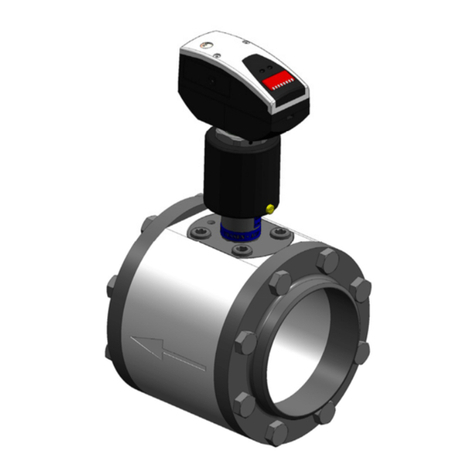envea AirFlow P User manual

OPERATING INSTRUCTIONS
AirFlow P
VOLUME CURRENT MEASUREMENT
ENVEA Process GmbH - Gutedelstraße 31 – 79418 Schliengen - GERMANY
Tel.: +49 (0) 7635 827248-0 / info.process@envea.global / www.envea.global

The display is touch-sensitive. Available keys are displayed directly in context. When the measuring
system is rst started, a query is initiated to select the language and sensor.
Initialization screen when the Evaluation unit in the eld housing
started rst time.
Selection of the menu language: Deutsch, English, Français.
If a language has been selected, the sensor to be used must be
selected. To be available:
SolidFlow 2.0, Paddy, PicoFlow, MaxxFlow HTC, DensFlow,
SpeedFlow 2.0, SlideControl 2.0, ProSens, M-Sens 2, M-Sens 3,
M-Sens WR, M-Sens WR2.
If any data has been changed, the change will only be taken
into account when you exit the complete menu structure and
answer [Yes] when asked if you wish to save the changes.
Afterwards the start page appears.
If you want to communicate with our sensor using our dedicated software, you need to download the
latest version on our website and install it.
https://www.envea.global/solutions/process-optimization/dahs-software/
It might also be necessary to install drivers, also available on our website.
1st start note
For the 1st use of the sensor, correct sensor type should be selected via the screen or the software.
Software must be installed if needed.
1. SOFTWARE INSTALLATION
2. MSE 300-FH (WITH SCREEN)
Select Language
D E F
E
#
$
8
Sensor
SolidFlow
Save changings?
J N

1st start note
Our dedicated software must be used to connect to the sensor evaluation unit.
Select software language
Right click on „Sprache/Language/
Langue“ and select desired language.
Connect to sensor
Select the correct COM port and
connect to the device using the „read
device“ button.
Select correct sensor
In the menu „System“, under „Sensor“
(8.2.5 or 7.2.5), the correct sensor must
be selected.
After selecting the sensor, check the
box „Overwrite measurement calib.“
and conrm with the button „Device
program“.
For more informations and details, ple-
ase refer to the user manual of the sen-
sor.
3. MSE 300-DR / -DR2 (NO SCREEN)

4
CONTENTS Page
1. System overview . . . . . . . . . . . . . . . . . . . . . . . . . . . . . . . . . . . . . . . . . . . . 5
2. Function . . . . . . . . . . . . . . . . . . . . . . . . . . . . . . . . . . . . . . . . . . . . . . . . . 7
3. Safety . . . . . . . . . . . . . . . . . . . . . . . . . . . . . . . . . . . . . . . . . . . . . . . . . . 8
3.1 Normal use . . . . . . . . . . . . . . . . . . . . . . . . . . . . . . . . . . . . . . . . . . . . . 8
3.2 Identication of hazards . . . . . . . . . . . . . . . . . . . . . . . . . . . . . . . . . . . . . 8
3.3 Occupational and operational safety. . . . . . . . . . . . . . . . . . . . . . . . . . . . . . 8
3.4 Maintenance . . . . . . . . . . . . . . . . . . . . . . . . . . . . . . . . . . . . . . . . . . . . 10
3.5 Technical statement. . . . . . . . . . . . . . . . . . . . . . . . . . . . . . . . . . . . . . . . 10
3.6 Reliability . . . . . . . . . . . . . . . . . . . . . . . . . . . . . . . . . . . . . . . . . . . . . . 10
3.7
Storage conditions
. . . . . . . . . . . . . . . . . . . . . . . . . . . . . . . . . . . . . . . . . 10
4. Mounting and installation . . . . . . . . . . . . . . . . . . . . . . . . . . . . . . . . . . . . . . . 11
4.1 Supplied equipment . . . . . . . . . . . . . . . . . . . . . . . . . . . . . . . . . . . . . . . 11
4.2 Required tools . . . . . . . . . . . . . . . . . . . . . . . . . . . . . . . . . . . . . . . . . . 11
4.3 Determining the installation position . . . . . . . . . . . . . . . . . . . . . . . . . . . . . 11
4.4 Installation in non-metallic lines . . . . . . . . . . . . . . . . . . . . . . . . . . . . . . . . 12
4.5 Installation of the sensor . . . . . . . . . . . . . . . . . . . . . . . . . . . . . . . . . . . . 13
4.6 Dimensions. . . . . . . . . . . . . . . . . . . . . . . . . . . . . . . . . . . . . . . . . . . . . 14
5. Electrical connection . . . . . . . . . . . . . . . . . . . . . . . . . . . . . . . . . . . . . . . . . 17
5.1 Terminal layout MSE 300-DR . . . . . . . . . . . . . . . . . . . . . . . . . . . . . . . . . . 17
5.2 Terminal layout MSE 300-DR2 . . . . . . . . . . . . . . . . . . . . . . . . . . . . . . . . . 18
5.3 Terminal layout MSE 300-FH . . . . . . . . . . . . . . . . . . . . . . . . . . . . . . . . . . 19
5.4 Terminal layout of C-Boxes . . . . . . . . . . . . . . . . . . . . . . . . . . . . . . . . . . . 20
5.5 Electrical connection sensor . . . . . . . . . . . . . . . . . . . . . . . . . . . . . . . . . . 21
6. Operator interface . . . . . . . . . . . . . . . . . . . . . . . . . . . . . . . . . . . . . . . . . . .22
6.1 Differences between the individual variants of the Evaluation units . . . . . . . . . . . .22
6.2 Conguration via Display . . . . . . . . . . . . . . . . . . . . . . . . . . . . . . . . . . . . 23
6.3 Conguration via PC-Software . . . . . . . . . . . . . . . . . . . . . . . . . . . . . . . . .25
6.4 One or more sensor systems . . . . . . . . . . . . . . . . . . . . . . . . . . . . . . . . . . 27
6.5 Menu structure . . . . . . . . . . . . . . . . . . . . . . . . . . . . . . . . . . . . . . . . . . 29
7. Start-up procedure. . . . . . . . . . . . . . . . . . . . . . . . . . . . . . . . . . . . . . . . . . .39
7.1 Basic start-up procedure . . . . . . . . . . . . . . . . . . . . . . . . . . . . . . . . . . . . .39
7.2 Datalogger function of the software . . . . . . . . . . . . . . . . . . . . . . . . . . . . . .39
7.3 Adjusting the measurement values . . . . . . . . . . . . . . . . . . . . . . . . . . . . . . 40
8. Error signalling . . . . . . . . . . . . . . . . . . . . . . . . . . . . . . . . . . . . . . . . . . . . . 41
9. Maintenance . . . . . . . . . . . . . . . . . . . . . . . . . . . . . . . . . . . . . . . . . . . . . . 42
10. Warranty. . . . . . . . . . . . . . . . . . . . . . . . . . . . . . . . . . . . . . . . . . . . . . . . .42
11. Troubleshooting . . . . . . . . . . . . . . . . . . . . . . . . . . . . . . . . . . . . . . . . . . . . 42
11.1 Error codes . . . . . . . . . . . . . . . . . . . . . . . . . . . . . . . . . . . . . . . . . . . . .43
12. Technical data . . . . . . . . . . . . . . . . . . . . . . . . . . . . . . . . . . . . . . . . . . . . . 44

5
1. System overview
A measuring point consists of the components:
•Evaluation unit in the DIN Rail housing or eld housing
•Double weld-on socket for sensor mounting
•Sensor (consisting of 2 x antenna, 1 x electronic box)
•Assembly instructions
•C1- or C3-Box (optional)
Sensor C1 box MSE 300-FH
max. 300 m
1 (+ 24 V)
2 (GND)
3 (A)
4 (B)
S (Earth)
C1-Box
(optional)
16 (+ 24 V)
15 (GND)
14 (A)
13 (B)
Sensor C1 box
max. 300 m
C1-Box
(optional)
MSE 300-DR / -DR2
Fig. 1: Overview with C1-Box and MSE 300-FH
Fig. 2: Overview with C1-Box and MSE 300-DR

6
MSE 300-FHC3 box
Sensor
Sensor
Sensor
max. 300 m
1 (+ 24 V)
2 (GND)
3 (A)
4 (B)
Shield
The system can be equipped with up to three sensors. Accordingly, different C-Boxes (C1, C3) are used.
Fig. 3: Overview with C3-Box and MSE 300-FH
Fig. 4: Overview with C3-Box and MSE 300-DR
C3 box
Sensor
Sensor
Sensor
max. 300 m
1 (+ 24 V)
2 (GND)
3 (A)
4 (B)
MSE 300-DR / -DR2

7
Fig. 5: AirFlow P in a pipeline
2. Function
The AirFlow P is a volumetric ow meter specially designed for dusty applications.
The sensor technology is based on the electrodynamic measuring principle. Every particle that
ies past the antenna within a radius of 300 mm generates an electrical signal. The signals
from the two antennas are further processed in the sensor‘s electronics box. The electronics
box of the sensor correlates the received signals of both antennas with each other and thus
determines the velocity.
For an output of the volume ow, the area of the pipe to be monitored must be stored in the
evaluation unit. The evaluation unit then calculates the measured velocity with the specied
area (A x v = m3/time).
The AirFlow P can also be used for pure speed measurement.

8
3. Safety
The measuring system has a state of the art, reliable design. It was tested and found to be in a perfectly safe
condition when leaving the factory. Nevertheless, the system components may present dangers to personnel
and items if they are not operated correctly.
Therefore, the operating manual must be read in full and the safety instructions followed to the letter.
If the device is not used correctly for its intended purpose the manufacturer's liability and warranty will be void.
3.1 Normal use
•The measuring system may only be installed in metallic pipes to measure the medium passing
through them. It is not suitable for any other use or measuring system modications.
•Only genuine spare parts and accessories from ENVEA Process may be used.
3.2 Identicationofhazards
•Possible dangers when using the measuring system are highlighted in the operating instructions with
the following symbols:
Warning!
•This symbolises a situation where personal safety is at risk if used in an improper manner.
Attention!
•This symbolises the possible damage to the system, if used in an improper manner.
3.3 Occupational and operational safety
•The measuring system must be installed by trained and authorised personnel only.
•Protective equipment must be worn to avoid injuries caused by possible sharp edges on the
measuring device.
•When using a cable with more than 4 cores, unused, open cores may cause sparking. Failure to
comply with the specied connection parameters of the cable will result in loss of intrinsic safety. To
prevent this, it is mandatory to use a 4-core shielded cable.
Always ensure that the connection parameters of the cable are within the specication (Li, Ci). The
shield of the cable must not be connected to the housing under any circumstances.
•When installed in an Ex zone, there is an increased risk of explosion, so it should always be ensured
that there is no Ex zone when carrying out installation work.
•Improper installation work leads to an increased risk of explosion. The device must always be installed
using the process-related seals and observing the torques. Mechanical stresses are to be avoided, for
example through supported installation.
•In case of improper assembly, there is an increased risk of explosion due to escaping dusts.
•When installing the measuring device, there is a risk of injury due to crushing. To avoid this, installation
work must always be carried out by two people.
•Improper mechanical stress (e.g. torsion) can cause damage to the device. To avoid this, the device
should always be installed in accordance with all the instructions in the operating manual.
The measuring device should also not be exposed to any vibrations if possible.

9
•If the device is operated under high pressured conditions, there is a risk of explosion. When cleaning
or blowing out the pipe and when transporting material, always ensure that the permissible pressure
according to the DGRL is not exceeded.
•Due to the process, hot components on the device can cause burns. It is strongly recommended to
wear the appropriate protective equipment and to let the device cool down before working on it.
•Improper use of the device will result in a high risk to system safety, therefore the device must only be
used as specied in the associated documentation.
•Make sure that the system is in a depressurised state during all maintenance, cleaning and inspection
work on the pipelines or on the components of the device.
•Switch off the power supply for all maintenance, cleaning or inspection works on the sensor or on
components. Follow the notes of the chapter maintenance.
•Caution, if welding is required on the pipe, remove sensor.
•The components and electrical connections must be checked for damages regularly. If a damage is
found, it is to be repaired before further operation of the instruments.
Risk of explosion, electric shock or damage due to incorrect or non-existent earthing
Incorrectly connected equipotential bonding can result in charges that can lead to explosions in an
explosive atmosphere, electric shock or device damage.
• Connect equipotential bonding at all points provided on the device components.
• For all work on the device described in these operating instructions, ensure that the equipotential
bonding is connected.
• Ensure that there is an earth connection via the power supply.
• Carry out regular checks of the earthing connections for correctness.
Risk of explosion from electrostatic charge when cleaning or blowing out
• No dangerous electrostatic charges may occur during cleaning and blowing out.
Standardization
• The provisions of IEC / EN 60079-17 must be observed during commissioning, installation and
maintenance.
Risk of explosion or electric shock due to improper installation work
Improper assessment of the installation site and all other installation work in the hazardous area can cause
serious damage to people and the company.
• Installation, commissioning, maintenance and testing may only be carried out by qualied personnel
who have knowledge of the rules and regulations for potentially explosive areas, in particular:
• types of protection
• installation rules
• zoning
• applicable standards
• local work safety regulations

10
3.4 Maintenance
•For maintenance purposes, it is imperative that the device is de-energised and cooled down,
otherwise there is an increased risk of explosion.
•Before working on the device or its components, it is essential to ensure that they are de-energised.
Otherwise there is a risk of electric shock.
•The correct tool must be used to open the device, otherwise there is a risk of injury and crushing.
•Before opening the device or its components, it is imperative to ensure that there is no EX zone.
•During cleaning work on the device or in the process, there is an increased risk of explosion due to
electrostatic discharges and excessive pressures.
3.5 Technical statement
The manufacturer reserves the right to change any technical data concerning technical developments,
without prior notice. If any queries arise, ENVEA Process GmbH will be happy to inform customers of any
possible changes made.
3.6 Reliability
For any additional information concerning product reliability, please contact ENVEA Process GmbH.
3.7 Storage conditions
Observe the following instructions during storage:
•To ensure shock resistance, store in original packaging.
•Do not remove protective discs or caps mounted on process connections.
They prevent mechanical damage and contamination to the sealing surfaces.
•Protect from sunlight to avoid impermissibly high surface temperatures.
•Store in a dry and dust-free place.
•Do not store outside.
Risk of electric shock when opening the evaluation unit
• Only open the housing if the system has previously been disconnected from the power supply.
Damage to the device due to improper mechanical stress
Improper handling (all mechanical stresses, e.g. torsion) can no longer guarantee pressure tightness.
• Tighten screw connections only with the torques specied in the operational instructions.
Risk of crushing with risk of injury when opening the lid
• Make sure to wear suitable protective equipment (e.g. gloves).
Risk of injury from sharp edges or splinters
• Make sure to wear suitable protective equipment (e.g. helmet, glasses, gloves, work shoes).

11
4. Mounting and installation
4.1 Supplied equipment
•Evaluation unit in the DIN Rail housing or eld housing
•Double weld-on socket for sensor mounting
•Sensor (consisting of 2 x antenna, 1 x electronic box)
•Assembly instructions
•C1- or C3-Box (optional)
4.2 Required tools
•Open-end wrench (36 mm)
•PZ 2 cross-recess screwdriver
•Suitable tools for the electrical connection
4.3 Determining the installation position
To determine the correct position of the AirFlow P, proceed as follows:
•The sensor can be used in round or angular pipes. In the case of horizontal or sloping
pipelines, the installation should be carried out from above.
•Depending on the geometry and size of the line to be monitored, several sensors are used:
- From a line size of 1500 mm 2 sensors are used.
- From a line size of 3000 mm 3 sensors are used.
•If several sensors are required for one measuring point, all sensors are distributed evenly on
the line at one installation height.
Optimally, the duct or pipeline continues horizontally or vertically upstream and downstream of
the installation point, and xtures such as bends, aps or gate valves have a minimum distance
to the sensor in both directions. (See Fig. 6)
3 x DN 3 x DN
3 x DN 3 x DN
3 x DN
3 x DN
3 x DN
3 x DN
Fig. 6: Recommended distances to valves, etc. (DN = nominal diameter)

12
In applications where the mounting location requirements cannot be fully met, the best
possible mounting position should be selected.
1. The AirFlow P should be installed so that the two antennas of the sensor are aligned with
the material ow.
2. In horizontal pipes with a round cross-section, the AirFlow P can be installed in any position
above the horizontal axis (between 9 and 3 o‘clock).
3. In horizontally running lines with a square cross-section, the installation can take place
centrally at the top or at the side.
4. Even if the sensor is not impaired in its function by vibration, strong vibrations should be
avoided as they can lead to the destruction of the electronics.
5. The sensor should not be exposed to direct sunlight, nor should it be used in areas with an
ambient temperature of more than 60 °C.
6. The sensor rods must not have any contact with the opposite line wall or any other device!
This would short-circuit the electrodynamic signal. To prevent this condition, the length of
the antennas can be shortened to a minimum length of 120 mm. The length of the antennas
is measured from the end of the screw-in thread.
The ceramic sleeve must not be damaged in any way.
7. In any case, it must be ensured that no contact occurs due to bridging in the event of
coating formation on the inner wall of the pipe.
8. For application with a smaller diameter than DN200, it is needed to ll in the questionaire,
so ENVEA Process will shorten the antennas to the correct length.
4.4 Installation in non-metallic lines
The sensor must be installed in a metallic duct to achieve sufcient shielding against electrical
inuences. In the case of non-metallic ducts, a sheathing of metal, a metal foil or a ne-meshed
metal mesh with a length of approx. 5 times the pipe diameter must be made upstream and
downstream of the measuring point. Furthermore, make sure that the duct and the sensor are
well grounded.

13
4.5 Installation of the sensor
At the selected installation position, the double weld-on sleeve must be installed on the line
wall and drilled out completely to the inner diameter of the sleeve. The sleeve must be installed
with the material ow direction.
Attention!
•After drilling, it is essential to check whether any burr has formed on the drill edges as a result
of drilling. Any burr that may have arisen in the pipe must be removed with an appropriate
tool. If the burr is not removed, this can have an influence on the calibration of the sensor!
•The two antennas are then screwed in tightly. The connections are to be checked for
tightness, appropriate sealing tape is to be used.
•Once both antennas are installed, the electronics box is pushed onto the antennas and
secured using the TriClamp connection. If the installation is correct, it should be possible to
insert the connectors of the electronics box into the antennas with a perfect fit.
•If the sensor is not installed immediately, the sealing caps must be screwed in until the time
of installation.
Attention!
•Use the correct tool (spanner size = S36) and apply it to the G 1“ screw connection.
•Use sealing tape
•Improper installation will void the warranty!
•Observe the seal on the TriClamp connections!

14
4.6 Dimensions
118
35
23
90
Fig. 7: Dimensions of the MSE 300-DR
Fig. 8: Dimensions of the MSE 300-DR2

15
Fig. 10: Dimensions C1 box
Fig. 11: Dimensions C3 box
max.
13 mm
max.
13 mm
50 mm
125 mm
113 mm
52 mm
80 mm
57 mm
4,8 mm
4,8 mm
5 mm
163 mm
175 mm
35 mm 35 mm 35 mm
23,5 mm
57 mm
52 mm
80 mm
max.
13 mm
max.
13 mm
max.
13 mm
max.
13 mm
5 mm
Fig. 9: Dimensions of the MSE 300-FH

16
Fig. 14: Dimensions AirFlow P sensor
120,0
220,00
100,0
466,7
160,8
Fig. 12: Dimensions G 1“ double socket Abb. 13: Dimensions G 1"-double-screw on-socket for
thin channels
G 1"
100 mm
43 mm
80 mm
226 mm

17
5. Electrical connection
Different variants of the Evaluation unit are available for the evaluation of the sensor signals.
The MSE 300-FH variants are supplied in an IP65 housing and can be installed in a free environment
according to the specication.
The MSE 300-DR variants are designed for installation in an electrical cabinet. The MSE 300-DR2 is a
variant of the MSE 300-DR and can be extended to a display as required.
Only the standard variants of all Evaluation units are described below. The Evaluation unit can be installed
at a maximum distance of 300 m from the sensor. A cable of type “Ölex Classic 110 CY” is recommended.
The cable should be four wired, twisted and shielded. A minimum cable cross-section of 0.75 mm2should
be observed. For distances more than 150 m the cable cross-section should be adjusted
.
5.1 Terminal layout MSE 300-DR
Fig. 15: Electrical connection of the MSE 300-DR
Current output
- 4 ... 20 mA
Current output
+ 4 ... 20 mA
Input Power
supply 0 V DC
Input Power
supply + 24 V DC
Not used Alarm relay
NC (break contact)
Alarm relay
C
Alarm relay
NO (make contact)
1 2 3 4
5 6 7 8
Digital pulse
output (-)
Digital pulse
output (+)
RS 485
Interface Data B
RS 485
Interface Data A
Sensor connection
Cable 4
RS 485 Data B
Sensor connection
Cable 3
RS 485 Data A
Sensor connection
Cable 2
Power supply 0 V
Sensor connection
Cable 1
Power supply + 24 V
9 10 11 12
13 14 15 16

18
5.2
Terminal layout MSE 300-DR2
Alarm relay
NO (make contact)
Alarm relay
C
Alarm relay
NC (break contact)
Not used
1. Digital pulse
output (+)
1. Digital pulse
output (-)
2. Digital pulse
output (+)
2. Digital pulse
output (-)
1. Current output
+ 4 ... 20 mA
1. Current output
- 4 ... 20 mA
2. Current output
+ 4 ... 20 mA
2. Current output
- 4 ... 20 mA
1 2 3 4
5
9
6
10
7
11
8
12
Sensor connection
Cable 1
Power supply +24 V
Sensor connection
Cable 2
Power supply 0 V
Sensor connection
Cable 3
RS 485 Data A
Sensor connection
Cable 4
RS 485 Data B
Input
Power supply
+ 24 V DC
Input
Power supply
0 V DC
RS 485
Interface
Data A
RS 485
Interface
Data B
Fig. 16: Electrical connection MSE 300-DR2
17 18 19
20
21
22 23 24

19
5.3 Terminal layout MSE 300-FH
Fig. 17: Electrical connection of the MSE 300-FH
L N PE
I-in 1 I-out 1
+ -
I-out 2 I-out 3
Alarm Relay
NO C NC
D-out RS 485
A B
GND
D-in 1 D-in 2 Sensor
+ - A B
Shield
+ - + - + - + -
+ -
+ -
Evaluation unit
Terminal No. Connection
Power supply connection
L / +24 V Input power supply 230 V / 50 Hz, 110 V / 60 Hz (optional 24 V DC)
N / 0 V Input power supply 230 V / 50 Hz, 110 V / 60 Hz (optional 24 V DC)
PE Earth
Connections
I-in1 +Current input +
-Current input -
I-out1 +Current output +
-Current output -
Na Not used
Na Not used
Na Not used
Na Not used
Min. /
Max.-
Relay
NO Floating change-over contact NO (make contact)
CFloating change-over contact C (common conductor)
NC Floating change-over contact NC (break contact)
D-out +Digital pulse output +
-Digital pulse output -
RS 485
ARS 485 interface data A
BRS 485 interface data B
GND RS 485 interface ground
D-in1 +Digital interface 1 (+)
-Digital interface 1 (-)
D-in2 +Digital interface 2 (+)
-Digital interface 2 (-)
Sensor
+Power supply + 24 V Cable no. 1
GND Power supply 0 V Cable no. 2
ARS 485 data A Cable no. 3
BRS 485 data B Cable no. 4
Shield Shield

20
5.4 Terminal layout of C-Boxes
It is not needed to install a C1-Box, the system also run without C1-Box.
The C1-Box could be installed in-between sensor and Evaluation unit. The C1-Box could be used to secure
the sensor and Evaluation unit in case of electric error.
The C3 box is absolutely necessary as soon as an averaging of up to three sensors at one measuring point
is to take place.
Evaluation unit Sensor 1 Sensor 2 Sensor 3
M20 M20
Fig. 18: Electrical connection C3-Box
Fig. 19: Electrical connection C1-Box
Cable gland
M 20 x 1.5
Sensor 1Evaluation unit
Sensor 1 / 2 / 3
1 Power supply + 24 V
2 Power supply 0 V
3 RS 485, data A
4 RS 485, data B
SShield
Evaluation unit
1 Power supply + 24 V
2 Power supply 0 V
3 RS 485, data A
4 RS 485, data B
SShield
Table of contents
Other envea Measuring Instrument manuals
